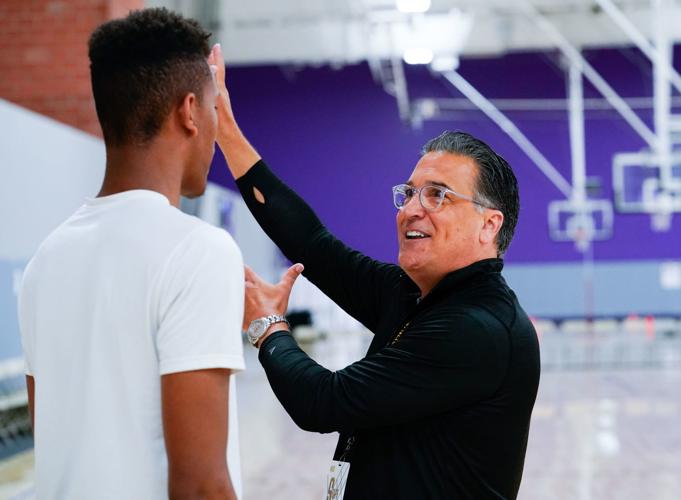PHOENIX — When college basketball prospects on the “1997 Arizona Wildcats” and “1995 UCLA Bruins” faced off inside the 7,000-seat GCU Arena on Tuesday evening, a row of prime courtside seats along the eastern sideline was cordoned off for college coaches to watch.
For most of the game, nobody sat there. The entire eastern side of the arena was empty, too, except for a couple of camera operators.
It was one of many sparsely attended games at the NCAA’s West Region Basketball Academy, for a simple reason: The elite talent was mostly elsewhere.
Of the roughly 300 players attending over two sessions in Phoenix, several talent observers said, less than half were Division I prospects, with most of them low- to mid-major ones at best.
“It’s good for us, with everybody on (our) campus,” GCU coach Dan Majerle said. “But they’ve got some things to work out. The level of competition — you’re not seeing a lot of the high-value kids.”
The camp was a new venture created by the NCAA in an effort to pull influence away from club-ball coaches and teams. It carried all the structure and organization characteristic of the NCAA, with teams named after NCAA champions, refreshment centers labeled for “student-athletes” and lessons about social media, eligibility and agent representation offered in addition to the standard drills and games.
“We’ve talked to a lot of coaches and they’re speaking a lot of knowledge,” said Hunter Sallis, a four-star 2021 wing from Nebraska. “I’m always down to learn something new. This is some good stuff.”
Sallis, who holds offers from high-majors such as Oregon, UCLA, Colorado, Iowa State and Nebraska, was one of only a handful of players who consistently drew crowds even though college coaches were invited to all six days of the NCAA camp competition.
Coaches couldn’t attend club-ball events being played elsewhere, even though there were still crowds at the Las Vegas Big Time Tournament for attractions such as five-star guard Josh Christopher and 15U magnet Bronny James (plus his famous father).
Then there was USA Basketball’s Junior Team camp in Colorado, which drew dozens of coaches for the two days they were allowed to watch, thanks to the 75 elite prospects on hand.
The “commissioner” of the West Region NCAA camp, former UCLA and St. John’s coach Steve Lavin, is aware of the challenges. Lavin said the camp may not be held at the same time as the USA camp in future years, while a selection team with talent evaluators could be added to ensure the best prospects are being invited to future camps.

Former UCLA and St. John’s coach Steve Lavin called the weeklong camp “the first step of a long journey.”
But Lavin also noted that the NCAA also needed to “add pieces that will increase our ability to attract some of the top people.”
During a half-hour media session, Lavin spoke at length about several other topics:
What are your duties as commissioner?
A: “A lot of it is asking questions (of coaches, referees and players) to get a collaborative kind of view. … There was an individual voluntary skill workout we had that we tapered. If we had (all of) it, they would definitely show up but you want them to have some legs, some gas in the tank for games, when they’ve got to perform.
“The fine line is you’re also giving them a sneak preview of what college is going to be like. We also want the camp to be rigorous enough and reflect the challenges that are ahead of them. In college, you’ve got study hall, weights, individual workouts, your regular team practice, film work, scouting sessions, and oh, by the way, a full set of classes. So we’re mindful. We don’t want to have a lot of injuries. We want to make sure they’re hydrated. We understand they gotta walk to the dorms, it’s hot outside, their attention span (may be limited) in dealing with the classroom part of it.”
Could this camp help clean up basketball?
A: “I think the historic aspect of this is you’re providing, for the first time, something that’s an alternative. And the majority of kids are still going to participate in (other events in) July because there are some fantastic events that are out there. We’re just providing something that we think is really special and unique, and has components that those camps don’t. More options for people to choose from.”
You’ve been around the game for a long time. Do you feel the club basketball scene has led to some things that are hurting the game?
“Overall, there’s always been challenges in college athletics, and they come in different forms or fashion. But this is one that now we’re addressing. And this academy is just one element that we are providing as an opportunity because we think it can be something special that’s sustainable.”
During your time at UCLA and St. John’s, did you think things were getting weirder and weirder, like something had to change? Or was it always the same?
“I think you just kind of realize in every aspect of life there’s going to be challenges, there’s gonna be changes and it’s how you adapt, how you use your ingenuity and resourcefulness, creative thinking, problem solving, to make things better.
“But by no means is this flipping a switch or some Pollyanna scenario. I don’t think anyone is naive to think that this is a quick fix.
“This is the first step of a long journey as we continue to work cooperatively with people from USA Basketball, the NBA, the NCAA, the NABC to try and improve the game and protect what’s great about the game.”






